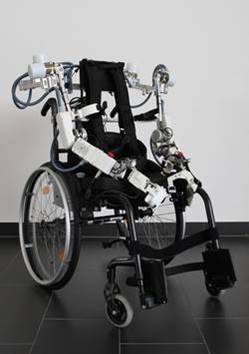Dual Arm Exoskeleton
Exoskeleton for upper body robotic assistance (Recupera REHA)
Contact person:
Technical Details
System description
The active dual arm exoskeleton is a human-machine-interface developed to enhance and optimize the workflow of upper body rehabilitation. The exoskeleton has five contact points to the operator and the kinematic structure follows the human movements of the arms. In order to achieve the autonomy required for rehabilitation applications, all processing is performed by an embedded computing system. The kinematic structure has five active degrees of freedom at each arm
Further Details:
- 3-hierarchical-layer-based control architecture. Robust cascaded velocity-position-current control on the low-level, dynamic control, gravity compensation and biosignal integration at mid-level (for the upper body) and controllability over a Web GUI at high-level
- 3 therapy modes:
- With the Master-Slave mode it is possible to control and move one arm with the other, resembling the classical mirror therapy approach.
- With the Teach-In and Replay mode movements from the arms can be tracked and saved, in order to replay them once or several times. The replayed trajectories can be triggered via EMG or EEG.
- In the gravity compensated free running mode the arms can be moved at will. Models of the human arm can be activated in order to compensate for the weight of the user’s arms
Videos
Recupera-REHA: First patient tests

By playing the video, you accept YouTube's privacy policy.
Together with the project partner rehaworks, first tests with stroke patients were made. All 3 therapy modes were tested.


